Helium-Cadmium Lasers
Helium-Cadmium Lasers - Java Tutorial /p>
Helium-cadmium (He/Cd) lasers are finding an increasing number of important applications in confocal microscopy due to their three primary emission spectral lines (322, 354, and 442 nanometers) in the ultraviolet and blue-violet regions. The shortest wavelength (322 nanometers) requires specialized ultraviolet transparent optics and is seldom used in microscopy, but membrane probes (such as indo-1 and fura-2) can be efficiently excited with the 354-nanometer line. The blue-violet spectral line is useful for a host of common fluorophores and fluorescent proteins in single, double, or triple labeling experiments. This interactive tutorial explores a simplified model of the helium-cadmium laser cavity operation.
The tutorial initializes with a cutaway drawing of a helium-cadmium gas laser illustrated in the central window, and having the operating speed set to Medium, a level that enables the visitor to observe the slow build-up of light in the laser cavity as it is reflected back and forth through the Brewster windows and mirrors. In order to operate the tutorial, translate the Laser Wavelength slider between the various available laser spectral lines (322, 354, 442 nanometers), and observe how the color of the output beam changes with wavelength. Use the Tutorial Speed slider to adjust the speed of light oscillations within the laser cavity and the level of light emitted through the output lens.
Helium-cadmium lasers (illustrated in Figure 1) are considered to be a member of the helium-neon family, and represent an economical source for continuous-wave output in the ultraviolet (322 nanometers at 75 milliwatts and 354 at 20 milliwatts) and blue-violet (442 nanometers at 200 milliwatts) spectral regions. These lasers rely on cadmium vapor as a lasing medium, which is distributed uniformly throughout the bore from the heated cadmium reservoir (at approximately 250 degrees Celsius) by gas-phase electrophoresis. The helium pump maintains a constant helium pressure, which is about a thousand times higher than that of the cadmium vapor. Helium-cadmium lasers display more beam noise than their helium-neon counterparts, primarily because of localized fluctuations in metallic cadmium vapor concentrations in the bore. They also have a shorter lifespan, typically around 5,000 operating hours.

One group of investigators has described the use of a ratio-imaging confocal microscope coupled to both an argon laser operating at 488 nanometers and a helium-cadmium laser emitting at 442 nanometers. This system allowed the group to measure the intensity ratio from the pH-sensitive dye BCECF [having an IUPAC name of 2',7'-bis-(2-carboxyethyl)-5-(and-6-)-carboxyfluorescein] in isolated renal tubules. Similar measurements have been made utilizing the 458-nanometer line of the argon laser in both widefield and confocal microscopy systems. Another researcher reported using the 325-nanometer output of a helium-cadmium laser to excite two dyes simultaneously and perform emission ratio imaging.
Because of the limited operational lifespan of helium-cadmium laser systems, several manufacturers have conducted research aimed at extending the useful life of the tube. New mirror technology has been introduced that improves the lifetime of the coatings to greater than 5000 hours for the 322-nanometer mirrors, but this effort does not represent a significant increase. At least one manufacturer distributes a sealed multiple-wavelength version of the helium-cadmium laser with a lifespan of over 10,000 hours and wavelength selection by external interference filters.
Sorry, this page is not
available in your country.